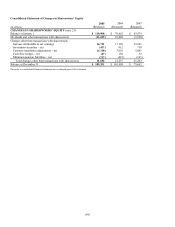GE 2005 Annual Report Download - page 62
Download and view the complete annual report
Please find page 62 of the 2005 GE annual report below. You can navigate through the pages in the report by either clicking on the pages listed below, or by using the keyword search tool below to find specific information within the annual report.(62)
In evaluating whether a particular relationship qualifies for hedge accounting, we first determine whether
the relationship meets the strict criteria to qualify for exemption from ongoing effectiveness testing. For a
relationship that does not meet these criteria, we test effectiveness at inception and quarterly there-after by
determining whether changes in the fair value of the derivative offset, within a specified range, changes in the fair
value of the hedged item. This test is conducted on a cumulative basis each reporting period. If fair value changes
fail this test, we discontinue applying hedge accounting to that relationship prospectively. Fair values of both the
derivative instrument and the hedged item are calculated using internal valuation models incorporating market-based
assumptions, subject to third party confirmation.
At December 31, 2005, derivative assets and liabilities were $1.9 billion and $2.2 billion, respectively.
Further information about our use of derivatives is provided in notes 1, 18 and 27.
OTHER LOSS CONTINGENCIES are recorded as liabilities when it is probable that a liability has been incurred
and the amount of the loss is reasonably estimable. Disclosure is required when there is a reasonable possibility that
the ultimate loss will materially exceed the recorded provision. Contingent liabilities are often resolved over long
time periods. Estimating probable losses requires analysis of multiple forecasts that often depend on judgments
about potential actions by third parties such as regulators. Further information is provided in notes 20 and 29.
Other Information
New Accounting Standard
In December 2004, the Financial Accounting Standards Board (FASB) issued Statement of Financial Accounting
Standards (SFAS) 123 (revised 2004), Share-Based Payment (SFAS 123R), which will be effective for us on
January 1, 2006. Among other things, SFAS 123R requires expensing the fair value of stock options, previously
optional accounting that we adopted voluntarily in 2002. The transitional effect of this provision of SFAS 123R will
be modest, consisting of a reduction in full-year 2006 net earnings of $9 million to expense the unvested portion of
options granted in 2001. SFAS 123R also will require us to change the classification of certain tax benefits from
share-based compensation deductions to financing rather than operating cash flows. While the effects of these future
tax deductions will depend on several variables, had SFAS 123R been in effect, approximately $0.3 billion would
have been required to be classified as financing, not operating, cash flows in both 2005 and 2004. Prior periods will
not be restated as a result of this accounting change.
Financial Measures that Supplement Generally Accepted Accounting Principles
We sometimes use information derived from consolidated financial information but not presented in our financial
statements prepared in accordance with U.S. generally accepted accounting principles (GAAP). Certain of these data
are considered “non-GAAP financial measures” under U.S. Securities and Exchange Commission rules.
Specifically, we have referred, in various sections of this Annual Report, to:
• Organic revenue growth in 2005
• Growth in Industrial cash from operating activities (CFOA) in 2005
• GE pre-tax earnings from continuing operations before accounting changes excluding GECS earnings from
continuing operations before accounting changes, and the corresponding effective tax rates, for the three years
ended December 31, 2005
























